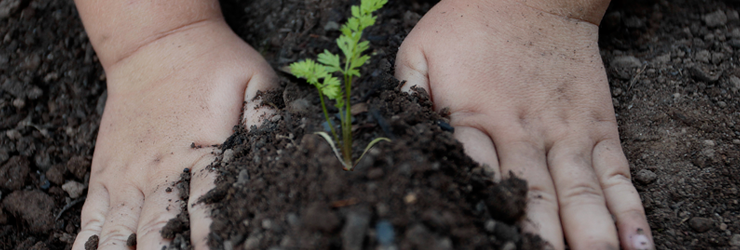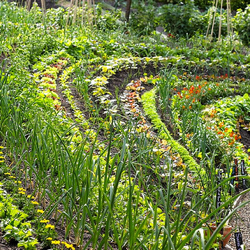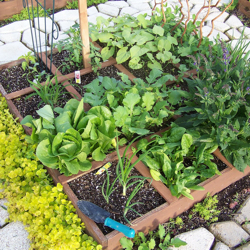Tips for Companion Planting

Many of today’s forward-thinking gardeners and greenhouse owners already know that certain plants tend to help other plants thrive, but many of us don’t really understand the concept. It’s called companion gardening and it works with the relationship of one plant or a group of plants that are planted with another group of plants to provide many different benefits resulting in increased crop productivity. Although it may sound like the latest in bio-science technology, companion planting has been around for centuries helping farmers and gardeners grow healthier, more prosperous crops.
Why use companion planting?
Companion gardening, when practiced correctly, can effectively solve many pest control, pollination, and elemental protection issues in other, less viable, plants. Companion gardening can be used successfully anywhere in the world and can benefit many different plant species.
Not only can certain plants be used to repel harmful insects, but there are still other plants whose job it is to attract certain insect species that are beneficial to the plants they are companioned with. The African marigold is well known for exuding chemicals through its root system and other above ground parts that repel pests better than any chemical process ever could. Companion planting is used to protect plants from not only insects but direct sunlight as well. Providing much-needed shade can help plants not only survive the harsh summer heat but thrive and even flourish.
Have you ever noticed that there is always a row of trees at one end or the other of a farmer’s field? This is an example of companion planting and the row of trees is acting as a windbreak to protect the crops from damaging high-speed winds blowing across the field.

Another interesting example of companion gardening is called Increased Level Interaction which basically means that one crop is grown over top of another crop to act as shade or protection from certain bird species. This is especially useful where space is limited and multiple crops are still required.
Trap Cropping is yet another example of companion gardening in which one plant that attracts a certain type of harmful insect is planted near a crop that needs protection from insects. The insects are drawn away from the beneficial crop and to the crop planted as a “trap” for them. This method saves money over buying potentially harmful pesticides.
This leads us to the Positive Hosting method of companion gardening involving certain trees or entire crops that have certain strict pollination requirements benefitting from different types of flower species being planted in the immediate area of the crop. The flower's main purpose is to attract pollinating insects in large quantities enabling the pollination process to become more widespread across the host crop.


Companion planting is by no means a new concept, having been practiced by civilizations all over the world, from China where Mosquito Fern is used as a companion plant for rice, to the Americas where the Three Sisters (mentioned above) of corn, squash and pole-beans were grown together. The Greeks and Romans utilized companion planting to improve the grapes they used to make wine, and Charles Darwin noted that red clover improved the quality of hay.
Many organic farmers and gardeners have realized the potential of companion planting as it  eliminates the need for harmful chemical pesticides and reduces insect damage, reduces weeds, and is a better, more natural way of fertilizing. Gardening more naturally using companion gardening means no more toxic chemicals and healthier, more nutritious plants and vegetables.
eliminates the need for harmful chemical pesticides and reduces insect damage, reduces weeds, and is a better, more natural way of fertilizing. Gardening more naturally using companion gardening means no more toxic chemicals and healthier, more nutritious plants and vegetables.
Another eco-friendly gardening practice is called “Square Foot Gardening” and it involves planting many different species of plant in a very small area, usually a container or raised bed gardening platform. This method is more often used in home gardens where space can sometimes be limited. Being able to grow several different plants in one small area benefits not only certain plants but the gardener as well, as they can produce a much more bountiful yield while using less space.
Much of what’s known about companion planting is anecdotal. This can mean you may (and likely will!) experience varying results. Some of these anecdotes go back thousands of years, however, and have produced consistent and reliable results through the centuries. The famous “three sisters” companion planting mentioned falls into this category. Though many companion plants are only anecdotal, there are scientific reasons, not yet fully explored, why many of these combinations work. In the future, we may come to find out that some of these pairings have no basis.
For the reasons above, it is important not to rely entirely on companion planting for good yields and positive results, but rather use it to supplement good growing practices. Good soil management, proper plant and row spacing, adequate drip irrigation, and crop rotation are the best practices for healthy, nutritious plants, with companion planting an important complement.
 As a note, some researchers take exception to some of the terms often used in companion planting guides. Phrases such as: “These plants love each other,” or the general term for the practice, “Companion Planting,” have come under criticism from academics for anthropomorphizing the behavior of plants, that is, assigning them human characteristics such as the emotion of love and the desire for companionship. This argument seems overly focused on semantics rather than the application of companion planting itself, but I should note that this guide attempts to steer away from companion planting advice that focuses on a plant’s “rhythm, vibration and music.” The emphasis in our companion planting chart will be on companion plantings that either have empirical evidence or significant anecdotal experience to support the pairings. If you’d like to read the research I referred to above, Dr. Linda Chalker-Scott, Extension Horticulturist and Associate Professor, Puyallup Research and Extension Center, Washington State University posted the article here: The Myth of Companion Plantings.
As a note, some researchers take exception to some of the terms often used in companion planting guides. Phrases such as: “These plants love each other,” or the general term for the practice, “Companion Planting,” have come under criticism from academics for anthropomorphizing the behavior of plants, that is, assigning them human characteristics such as the emotion of love and the desire for companionship. This argument seems overly focused on semantics rather than the application of companion planting itself, but I should note that this guide attempts to steer away from companion planting advice that focuses on a plant’s “rhythm, vibration and music.” The emphasis in our companion planting chart will be on companion plantings that either have empirical evidence or significant anecdotal experience to support the pairings. If you’d like to read the research I referred to above, Dr. Linda Chalker-Scott, Extension Horticulturist and Associate Professor, Puyallup Research and Extension Center, Washington State University posted the article here: The Myth of Companion Plantings.
Below are common companion planting combinations. Many of these are anecdotal in application, but have yielded consistent results amongst a wide variety of growers in diverse geographical locations. If there is a pairing you’ve had great success with, please don’t hesitate to email us at support@dripdepot.com so we can get it added to the list. No list of companion plants will ever be complete.

There are several irrigation kits that can be used to aid in the success of your companion gardening methods and they will allow you to maintain a healthy garden from first plant, all the way to harvest.
Thank you for reading. If you have any questions, comments or feedback, please Contact Us. We read and reply to every message we receive and would love to assist with your questions and learn from your feedback.